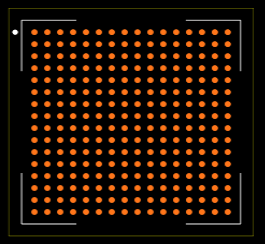EP3C16F256I7N FPGAs: Features and Applications and Datasheet
2025-01-23 10:15:03 1213
EP3C16F256I7N Description
The EP3C16F256I7N is an FPGA (Field Programmable Gate Array) from Altera's Cyclone III family, designed to deliver low power consumption, high performance, and cost-effective solutions. It features a high logic density with a 16,640 logic element (LE) architecture, making it suitable for a range of applications including consumer, industrial, and communications systems. The device comes in a 256-pin FineLine BGA (FBGA) package and supports industrial temperature ranges.
EP3C16F256I7N Features
Logic Elements: 16,640 LEs for flexible logic implementation.
Memory: Embedded memory blocks providing 504 Kbits of on-chip RAM.
I/O Pins: Up to 182 I/O pins with support for various I/O standards.
Low Power: Optimized for low static and dynamic power consumption.
Performance: Operates at a maximum frequency of 315 MHz, suitable for high-speed applications.
Temperature Range: Supports industrial temperature range (-40°C to +100°C).
Configurable PLLs: Four phase-locked loops (PLLs) for flexible clock management.
Package: 256-pin FineLine BGA package for compact designs.
EP3C16F256I7N Applications
Consumer Electronics: Home automation, display controllers, and audio processing.
Industrial Systems: Motor control, industrial networking, and instrumentation.
Communications: Ethernet switches, routers, and wireless communication systems.
Medical Devices: Imaging systems and diagnostic equipment.
Automotive Systems: Infotainment and advanced driver assistance systems (ADAS).
EP3C16F256I7N CAD Model
Footprint

3D Model


EP3C16F256I7N Alternatives
EP3C25F324I7N: Higher capacity with 24,624 LEs.
EP4CE22F17C6N: From the Cyclone IV family, offering better performance and power efficiency.
Xilinx Spartan-6 XC6SLX16-2CSG225C: A similar FPGA with competitive performance.
Lattice ECP5-12F: A low-power FPGA alternative for cost-sensitive applications.
Microchip PolarFire MPF100T: Focused on ultra-low power and high-security applications.
EP3C16F256I7N Manufacturer
Intel Corporation, founded in 1968 and headquartered in Santa Clara, California, is a global leader in semiconductor innovation. Renowned for its microprocessors, including the Intel® Core™, Xeon®, and Atom® series, Intel powers a wide range of computing devices. The company is pivotal in advancing technologies like AI, autonomous vehicles, and 5G. With cutting-edge manufacturing processes and a strong focus on sustainability, Intel drives innovation across hardware and software ecosystems, shaping the future of connected and intelligent systems worldwide.
EP3C16F256I7N FAQs
What is the configuration method for the EP3C16F256I7N?
The EP3C16F256I7N supports configuration via JTAG, Active Serial (AS), and Passive Serial (PS) methods using an Altera configuration device or a microcontroller.
What is the maximum operating frequency of this FPGA?
The maximum operating frequency is 315 MHz, depending on the logic design and resource utilization.
How much on-chip RAM is available in the EP3C16F256I7N?
The device includes 504 Kbits of embedded memory for data storage and buffering.
What I/O standards are supported by the EP3C16F256I7N?
It supports a variety of I/O standards, including LVTTL, LVCMOS, PCI, SSTL, and HSTL.
Is the EP3C16F256I7N suitable for industrial applications?
Yes, with its industrial temperature range (-40°C to +100°C) and robust design, it is ideal for industrial applications.




